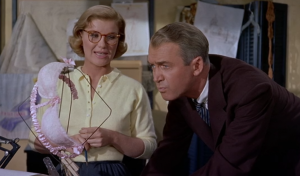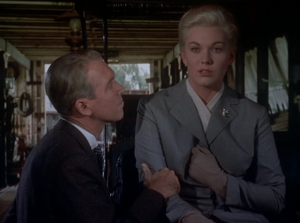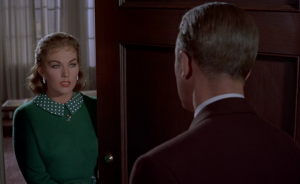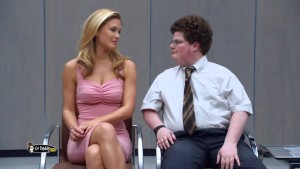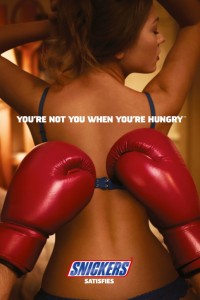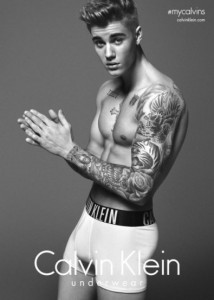Vertigo was an incredibly confusing film for more reasons than one, but what I’d like to draw your attention to is the aspect of love (or lack thereof) in this film. To say the least, it was most certainly eye-opening, but I might’ve preferred my eyes stayed shut.
Before we get into the deep stuff, I’d just like to say that my favorite part of the entire movie was probably the precredits, because the animation was nice and that’s before anyone’s mental health was completely obliterated. It was a peaceful time.
Jumping to the second scene, after John Ferguson (who is, I suppose, our protagonist) has experienced his trauma, we find the first woman to whom he’s had an obvious attraction. An engagement of three weeks with Marjorie “Midge” Wood (Fig. 1) occurred with our protagonist whilst they were still in college, and her presence was quite frankly a little bemusing to me, because the goal of her character is rather unclear.
The movie then starts to move along, and then a second female is introduced into the life of John Ferguson. This gal, however, is a bit trickier than Midge (who seems to be a bit of a “Plain Jane”). In this light, I might venture to say that Madeleine Elster (Fig. 2) might represent the “wild side” of femininity that darling Midge just didn’t have either the courage or the audacity to sport in the 1950s.
After John and Madeleine spend some quality time together, however, he appears to shift from being interested in the woman to whom he was once engaged, to being infatuated with this new, mysterious woman.
I think it is also worth mentioning that this is after poor Midge pulls out all the stops for him. She says that she’s “gone back to her first love, painting” (01:07:19), and then displays to him her 50s era photoshop (Fig. 3) of Portrait of Carlotta. Despite her best intentions, John is not amused, and I feel as if the entire audience mourns with her in her obvious despair.
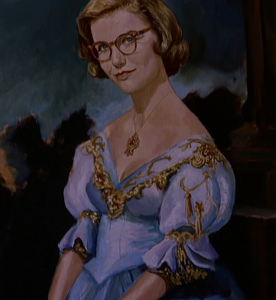
FIG. 3, Portrait of Carlotta, feat. Midge; Vertigo. Hitchcock, Alfred. Time stamp: (approx.) 01:07:40.
Alright, here’s the kicker. We see little Johnny in the asylum, which is understandable, and then we see Midge, taking care of him, putting him on some music. After this, darling Marjorie doesn’t appear onstage again. Very agitating.
Fast-forwarding again to when John is out of asylum and back on his feet. He catches a glimpse of a woman he once claims to have known, and after taking her to dinner, he appears to develop significant interest. Even though it isn’t implied that he and Judy Barton (A.K.A. Madeleine Elster) have any sort of sexual relations, especially considering her hostility (Fig. 4) during their introduction, he is absolutely obsessed with her appearance. I’m confident that he gleans more emotional satisfaction from her looking like the late Madeleine Elster than he would if they actually had intercourse, qualifying this as a full-blown fetish.
When I reconciled within myself the later dressing up of Judy to mirror Madeleine’s appearance, something clicked, and it irritates the fire out of me:
When Judy wants to be herself, Johnny boy can’t take it. He refuses to enjoy her until she becomes the Madeleine for whom his heart aches. In lieu of that, she changes, for him, to gain his affection. Now, contrast this with Midge (bless her heart, as my great-grandma would’ve said). Midge changes herself voluntarily in slapping her face on that painting, all for sorry old Johnny. She takes something that she is not, and applies herself to it, presumably in the interest of attracting John. This, however, he does not appreciate, but despises. I think he’s an idiot, but that’s just my opinion.
I have a lot of questions, and here are some of them:
Why is Midge’s change of appearance worth less to John, even though hers is voluntary and Judy’s is not? Shouldn’t hers be more attractive, since she’s wanting to change to please him, and Judy is uncomfortable and apprehensive?
How do these love (or lust) interests relate to one another, to femininity, and to masculinity’s perception of the female appearance?
Is it that Midge is too “easy”, or that Madeleine (not Judy; his fantasy involves one personality, but not the other) is more “eccentric”, and is that why John doesn’t find them equally attractive?
Finally, if they were both Medusa, would John suddenly be equally attracted to them, or would he still prefer the more fantastic (emphasis on fantasy) Madeleine Elster over our beloved Marjorie “Midge” Wood? And yes, this is a totally serious question.
Vertigo. Dir. Alfred Hitchcock. Perf. Kim Novak and James Stewart. Netflix (Argentina). Web. 2 Mar. 2016.
